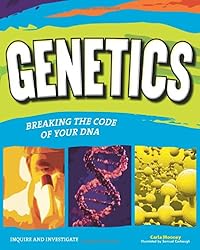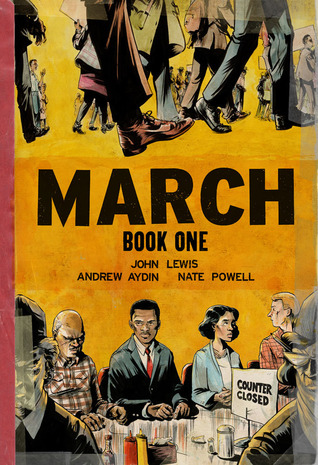Today, I have three civil rights related books to share. I thought it would be appropriate to share them now because the 50th anniversary of the Freedom Summer murders was just two days ago. I hope that none of us ever forget the sacrifices that have been made to achieve civil rights.
ABOUT THE BOOK
Congressman John Lewis (GA-5) is an American icon, one of the key figures of the civil rights movement. His commitment to justice and nonviolence has taken him from an Alabama sharecropper’s farm to the halls of Congress, from a segregated schoolroom to the 1963 March on Washington, and from receiving beatings from state troopers to receiving the Medal of Freedom from the first African-American president.
Now, to share his remarkable story with new generations, Lewis presents March, a graphic novel trilogy, in collaboration with co-writer Andrew Aydin and New York Times best-selling artist Nate Powell (winner of the Eisner Award and LA Times Book Prize finalist for Swallow Me Whole).
March is a vivid first-hand account of John Lewis’ lifelong struggle for civil and human rights, meditating in the modern age on the distance traveled since the days of Jim Crow and segregation. Rooted in Lewis’ personal story, it also reflects on the highs and lows of the broader civil rights movement.
Book One spans John Lewis’ youth in rural Alabama, his life-changing meeting with Martin Luther King, Jr., the birth of the Nashville Student Movement, and their battle to tear down segregation through nonviolent lunch counter sit-ins, building to a stunning climax on the steps of City Hall.
Many years ago, John Lewis and other student activists drew inspiration from the 1950s comic book “Martin Luther King and the Montgomery Story.” Now, his own comics bring those days to life for a new audience, testifying to a movement whose echoes will be heard for generations.
REVIEW
This graphic account of John Lewis’s life is very well done. I am assuming this is the first of several volumes about Lewis’s involvement with the Civil Rights Movement. It starts with Lewis as a Congressman getting ready to leave for Obama’s inauguration. Visitors arrive and he starts sharing pieces of his life. A beautiful depiction of the powerful drive that led Lewis and others like him to face serious abuse and persecution in the name of civil rights. This is a great beginning book for those looking to learn about the civil rights movement and some of those involved in it.
ABOUT THE BOOK
To coincide with the 50th anniversary of the Freedom Summer murders, this will be the first book for young adults to explore the harrowing true story of three civil rights workers slain by the KKK.
In June of 1964, three idealistic young men (one black and two white) were lynched by the Ku Klux Klan in Mississippi. They were trying to register African Americans to vote as part of the Freedom Summer effort to bring democracy to the South. Their disappearance and murder caused a national uproar and was one of the most significant incidents of the Civil Rights Movement, and contributed to the passage of the Civil Rights Act of 1964.
THE FREEDOM SUMMER MURDERS will be the first book for young people to take a comprehensive look at the brutal murders of James Chaney, Andrew Goodman, and Michael Schwerner, through to the conviction in 2005 of mastermind Edgar Ray Killen.
REVIEW
I found this to be a powerfully told story about the Civil Rights era. During the Freedom Summer of 1964 when several groups were working to obtain voting rights for blacks throughout the south, three young men disappeared. Mitchell explains the circumstances surrounding their disappearance before giving a brief biography of each of the three young men, two white and one black. Even in death there was great bigotry. The two white young men were shot, the black young man was severely beaten and probably dead before he was shot. The author then shares the events leading to the discovery of their bodies and the trials and memorials connected to their deaths.
This story illustrates in a sickening way the circumstances existing in the South during the 1960s and long before. The sad thing is, that it’s apparent from the get go that if two of the three hadn’t been white, the case would not have drawn the attention that it did. The KKK did so much harm to so many and yet was so rarely brought to justice. Once again that is illustrated here. The main instigator was let go until 2005 when he was finally convicted yet even then he was only convicted of manslaughter rather than murder which it so clearly was.. And many of the others got off with just a few years in prison.
One of the things that stuck with me the most is a statement made by the author, “Many people feel that this country is not yet at the place where the killing of a black mother’s son is as important as the killing of a white mother’s son. But the United States is closer to that goal than it was in 1964.” (pg. 183)
I hope that we keep moving forward toward the day when as the author says the killing of a black mother’s son is a tragedy equal to the killing of a white mother’s son.
BLACK & WHITE
ABOUT THE BOOK
In the 1950s and early 60s, Birmingham, Alabama, became known as Bombingham. At the center of this violent time in the fight for civil rights, and standing at opposite ends, were Reverend Fred L. Shuttlesworth and Eugene Bull Connor. From his pulpit, Shuttlesworth agitated for racial equality, while Commissioner Connor fought for the status quo. Relying on court documents, police and FBI reports, newspapers, interviews, and photographs, the author first covers each man’s life and then brings them together to show how their confrontation brought about significant change to the southern city.
REVIEW
I think the thing that sticks out to me most about this book is the power that one person can have to make a difference for either good or evil. Despite tremendous pressure and attempts on his life, Shuttleworth refused to back down from his efforts to end segregation. He was arrested numerous times, beaten up several times, had his home blown up and he still refused to give in. Connor on the other hand was just as committed to keeping segregation in place and wasn’t above using his political position to fight for the status quo. In the end though his hatred and violent methods backfired on him. Shuttleworth’s commitment to the nonviolent approach even in the face of great violence helped win the day.
This is a fascinating comparison of two men who were completely committed to a cause but who used very different methods and the chosen methods ended up determining the end result. A great example that indeed the end does NOT justify the means.
Be sure to visit my blog for other review, Geo Librarian.



















